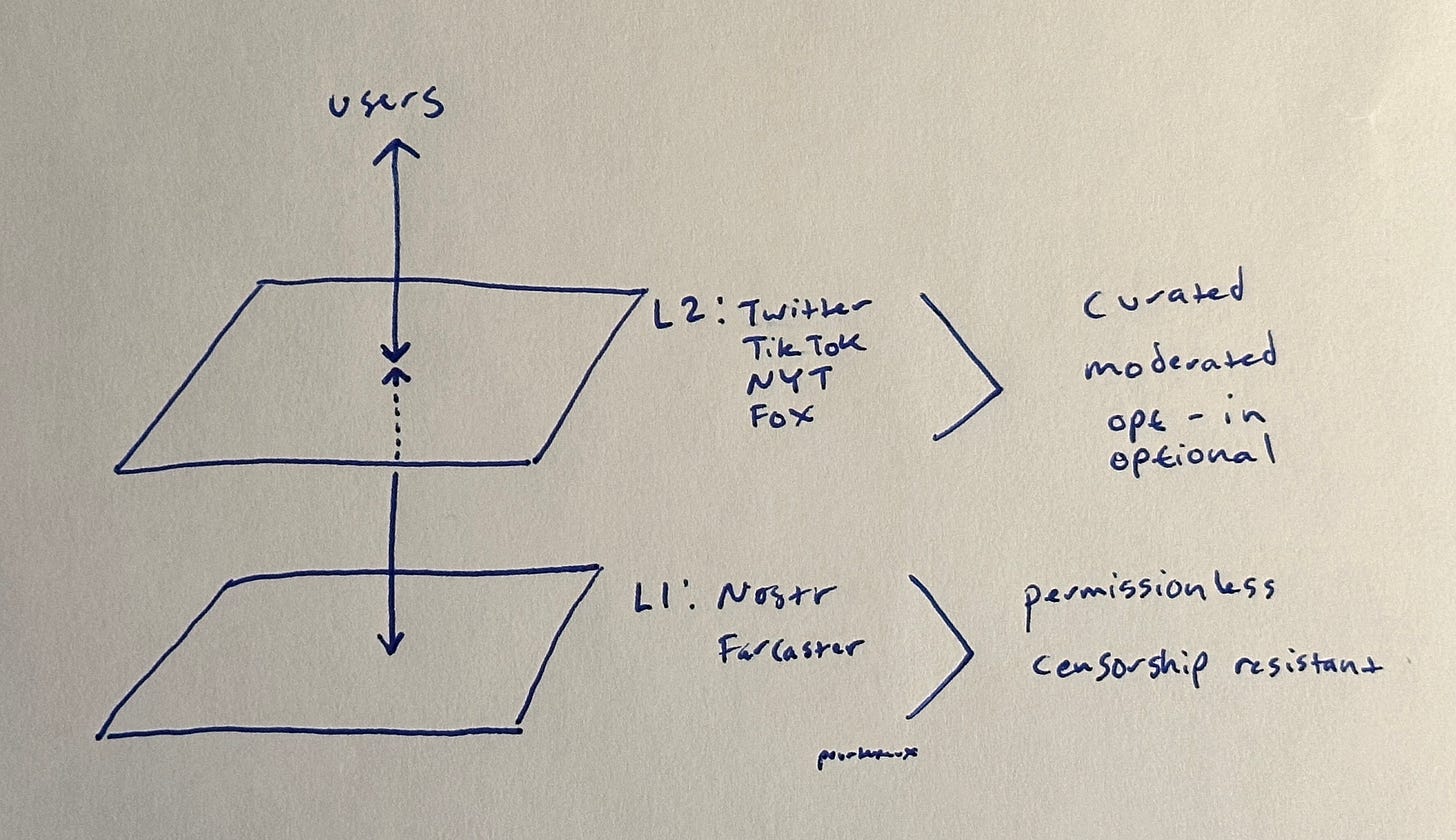The moral imperative of a distributed social layer
How Nostr or Farcaster aim to address the fundamental problem in social, satisfying everyone along the way
I’ve long been a critic of the idea that Twitter is a “town square” where moderation is termed “censorship,” and users are entitled to platform membership and a captive audience. Advocates of this position see Twitter almost as a utility and believe that activities to moderate the platform are actually unconstitutional limits on speech (leave aside that the First Amendment states that “Congress shall make no law…”). Surprisingly, this is the modern “new wave” libertarian perspective, and its proponents justify it by claiming that Twitter has a monopoly due to its insurmountable network effect, and thus doesn’t deserve typical protections for private companies.
I subscribe to the older libertarian point of view: Twitter is a private company that sets its own Terms of Service and the government shouldn’t be making operational decisions on Twitter’s behalf. No one should be entitled to the services of a private company and there exist limitless places to practice free speech without laying claim to the audience of a particular platform. Obviously, it is bad for Twitter’s business to platform hate speech because they will lose advertisers. The idea that you can’t compete with Twitter is ludicrous. There are ample social network competitors, like Facebook and TikTok, and there are direct competitors like Gab, Mastodon, Truth Social, and others. The new wave libertarians argue that those banned from Twitter “can’t just go start their own social network,” but that’s literarily what the former president did with Truth Social after he was banned following Jan 6th. Furthermore, many of the people who claim “censorship” actually have giant platforms and typically use “censorship” claims as a populist growth hack.
Not only is it well within Twitter’s right as a private company to moderate speech however they see fit, a well curated platform makes Twitter a better user experience and a more profitable business. Almost no one wants a 4chan free-for-all on their Twitter timeline. Elon Musk did us all a favor when he took over Twitter by quickly proving this point to the Right: the guy who promised to “free the bird” limits speech just as much if not more than the former leadership of Twitter. He does it more impulsively, with less procedure, and from a right-of-center bias, but the point is that he does it. Unmoderated Twitter is and always has been untenable. A private company cannot create a platform of truly unhindered speech, and when they try, they become cesspools ignored by almost everyone and devoid of a business model, like 4chan.
This being the case, you may wonder then—why would I advocate for an open, permissionless, and censorship resistant social network?
New social layers allow us to satisfy both those who want a totally open “town square,” as well as those who prioritize a well-moderated and curated experience. While these two perspectives seem to be in opposition, they are actually perfectly aligned. In fact, I don’t think the two groups represented by these statements disagree at all, they are just noticing a different part of the dysfunction in modern social networks. Private companies have spent the last several years trying, and failing, to be both champions of free speech and places with basic rules of decency.
You can’t do both. Governments, advertisers, employees, and public pressure will force private companies to moderate speech. And, any moderation action is potentially abused in the future and likely to disenfranchise a lot of people.
Private companies cannot be public squares, but a protocol can.
A protocol, like Nostr or Farcaster, can be permissionless and censorship resistant because there is no one to send a takedown request to in a distributed network. This is an incomplete solution, because if you stop here then you just have a distributed 4chan which is of interest to basically no one. You need a second layer of private companies and clients to act as curators and moderators. Users can opt-in and pay for this curated layer to provide them a better experience. Depending on your worldview, you may pay for layer 2 curation from the New York Times or from the Joe Rogan Experience. Twitter itself may be a curator of content from Nostr or Farcaster (or both) and serve you ads alongside content to make the platform free. There may be some overlap in the moderation decisions of all these different L2 operators, but there will also be plenty of moderation decisions that don’t overlap. Thus, no one is at risk of being “deplatformed,” unless you accomplish the impossible task of being banned by all the different L2 curators simultaneously. Even then, such an individual’s posts would still be viewable on the unmoderated L1 for those who can stomach it.
Thus “social layers” solve what both sides of the political spectrum want: a social platform free from concerns of “censorship” and “deplatforming,” while also allowing users to opt-in to a curated experience from moderators that they trust!

Let’s dive into two attempts at this L1: Nostr and Farcaster. I’ve had the pleasure of using both and will give my non-technical experience with both and the potential and limitations I see. I also want to thank fiatjaf (built Nostr) for helping me understand nostr, and Dan Romero (founder Farcaster) for inviting me to Farcaster. I also owe a debt of gratitude to Maciek Laskus who has thoroughly analyzed each and for speaking with me on the topic. Let’s start with a table:

Both Nostr and Farcaster use relays (called “hubs” in Farcaster) to store and transmit social data (like posts) to users (who run software, called “clients”). Farcaster uses the Ethereum architecture (eg, uses ethereum key-pairs for accounts), while Nostr does not use a blockchain (though you see a lot of lightning transactions, and theoretically could support any blockchain).
Notably, Farcaster is a VC-backed company with a known team and a polished product, while Nostr is not a company at all, built by an anon with no funding (though later received a 14 btc grant from jack), and is noticeably earlier in development. Speaking with fiatjaf, I confirmed that the only funding to Nostr has been this bitcoin grant from Jack that fiatjaf then split with jb55, who is developing the Damus client on iOS and macOS. Both Farcaster and Nostr have clients and services already built on top (examples: Nostr, Farcaster), though Farcaster seems further along in this process. Indeed, some of the design choices made by Farcaster make development easier, while the simplicity of Nostr makes the tradeoff of more near term difficult development with more future potential use-cases.
For example, Farcaster currently requires full synchronization of all hubs in the network, which makes developing clients easier. In contrast, Nostr allows relays to host or delete any content, which makes client development more difficult in the near term, but allows for numerous potential business models for these relays and more open ended potential use cases. Relays on Nostr could then charge subscription fees or serve ads or otherwise select which content to include and exclude.

The current user base for Nostr is mostly bitcoiners and the user base for Farcaster is mostly ethereans and tech entrepreneurs. In many ways, this is also reflected in the design choices of each platform. Like bitcoin, Nostr prioritizes simplicity, neutrality, and the ease of running your own relay (like a node in bitcoin). As with bitcoin, Nostr eschews VCs, forming a company, or having a known founder. Running a hub is more difficult and expensive with Farcaster, but makes certain design tradeoffs that Farcaster asserts still allows “sufficient decentralization” while prioritizing nearer term use cases and a polished product nearly ready for retail users.
I have an account on both platforms (@pourteaux.com on Nostr, @px on Farcaster). Simply put, Nostr seems to be following a cypherpunk and bitcoin ethos, where simplicity and a robust protocol are paramount. I am immensely impressed by fiatjaf, jb55, and other contributors. Farcaster is following a more conventional tech start-up model, and their product is beautifully polished and delightful today, as-is. Both efforts are on a mission to create a native social layer for the internet: a task which I believe is a moral imperative. So much societal dysfunction is the result of our current corporate social layers which try to be all things to all people. A layered approach to social media marries cypherpunk principles in an L1 with the importance of institutions in L2 to serve a social experience curated to the needs of every individual.




I love this concept!
One concern I have is how this might exacerbate the "echo chamber" effects that a lot of people complain about with modern social media (and the almighty "algorithm"). If I were to join a politically-aligned L2 Twitter clone, I probably wouldn't get the same discourse as I would on a more neutral (or attempted neutral) platform like today's Twitter, since only likeminded people would probably join that L2.
Conceptually though, it makes a lot of sense - divide up users into various L2s (i.e. the UI/UX) that are built on top of a simple protocol. (I also tend to lean toward the Nostr approach.)
Great piece.
These are not really solving new technical problems, they are basically darkweb markets with a nice UI. The true challenge is being tackled by the Bluesky team, with their ATprotocol and Lexicons. This will enable competing applications to understand and render the schemas of foreigns apps natively. The need to "hard fork" the schemas every time you want to add a new feature ( ie. gab.com forking mastodon and adding groups ) is what stopped decentralized apps from achieving any sort of network effect.